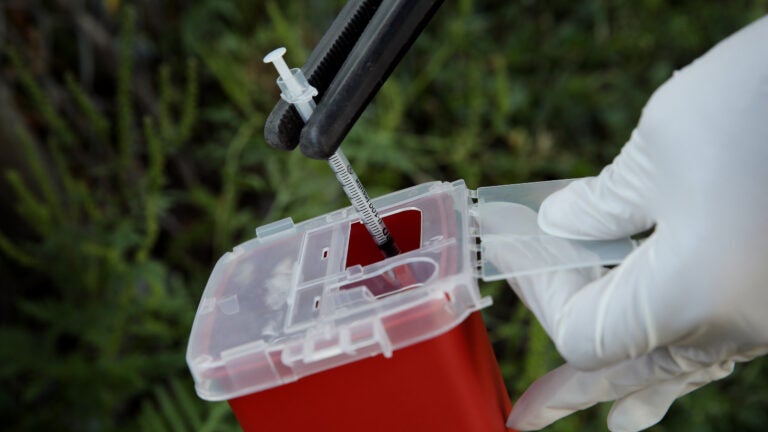Health
More than 2,300 people in Massachusetts died from opioid-related overdoses in 2022, a 2.5% increase from the previous year. Black and Hispanic people were particularly affected.

The number of opioid-related overdose deaths in Massachusetts increased by 2.5% in 2022, surpassing the previous peak for the most ever recorded in the state.
A total of 2,357 confirmed and estimated opioid-related overdose deaths were recorded for 2022, up from the 2,300 recorded in 2021, according to semiannual data released by the Department of Public Health. The number of deaths recorded in 2021 was also a record at the time.
The number of opioid-related overdose deaths among Black and Hispanic people rose significantly in 2022. The death rate of non-Hispanic Black residents increased by 42%, from 36.4 to 51.7 deaths per 100,000 residents from 2021 to 2022. The death rate of Hispanic residents increased by 16%, from 39.1 to 45.5 deaths per 100,000 residents.
Non-Hispanic Black men had the highest opioid-related overdose death rate among males in any racial or ethnic group, with a 41 percent increase from 2021 to 2022.
“Too many Massachusetts families, particularly families of color, have been impacted by this crisis, and in order to effectively respond, we need to address the gaps in the system by advancing long-term solutions that include housing, jobs, mental health care and more resources for our cities and towns,” Gov. Maura Healey said in a statement.
Places like Gloucester, Haverhill, Norton, Salem, and Taunton experienced notable decreases in opioid-related overdose deaths, while places such as Lawrence, Leominster, Lynn, Springfield, Waltham, Weymouth, and Worcester experienced notable increases.
Preliminary data from this year could offer a glimpse of hope. In the first three months of 2023, there were 522 confirmed and estimated opioid-related overdose deaths, a 7.7% decrease from the same time period in 2022.
The overall opioid overdose death rate in Massachusetts rose dramatically from 2013 to 2016, before decreasing slightly from 2016 to 2019. They have been rising gradually since.
State officials are focusing on increasing the availability of naloxone, which is used to reverse overdoses. Massachusetts has already exceeded federal naloxone “saturation” goals, and plans to keep expanding access, according to Healey’s office.
The DPH has distributed almost 300,000 naloxone kits since 2020 to places like harm reduction programs, treatment providers, community health centers, and emergency departments. Distribution of naloxone has increased about 40% each year, officials said.
The DPH is spending a lot more money on naloxone. It invested $2.9 million in the drug in 2018, and that rose to $7 million in 2022.
Earlier this year, the U.S. Food and Drug Administration approved over-the-counter sales of Narcan, a nasal spray that is the best-known form of naloxone. A statewide standing order continues to urge retail pharmacies to dispense naloxone without a prescription.
Fentanyl, an extremely potent synthetic opioid commonly mixed with street drugs, continues to have an outsized impact on overdose deaths in Massachusetts. Last year, fentanyl was present in 93% of the opioid‐related overdoses deaths where a toxicology screen was also available, according to DPH data. Cocaine was present in 53% and alcohol was present in 28%.
Xylazine, an animal tranquilizer, is posing a growing risk to residents. Although it is meant to be used as a veterinary sedative, xylazine is instead being mixed into other street drugs. Xylazine was present in 5% of Massachusetts overdose deaths last year.
Recently, dozens of states have passed and enacted legislation that increases penalties for those that give fentanyl to someone that then dies from it.
“We are falling back on these really comfy, straightforward law-and-order solutions in spite of the fact that they didn’t work before, they’re not working now, and there’s growing evidence telling us they’re making things worse,” Jennifer Carroll, a medical anthropologist at North Carolina State University, told The New York Times.
Compared to these other states, Massachusetts officials said this week that they are continuing to focus on making drugs less dangerous and preventing overdose deaths.
“We understand that to address the opioid crisis, we need to prioritize overdose death prevention while simultaneously investing in comprehensive supports for those dealing with substance use disorder, to ensure they have every opportunity for recovery,” Secretary of Health and Human Services Kate Walsh said in a statement. “We have to lean into the disparities we see in impacts on Black residents and target our interventions accordingly. Challenges like housing, hunger, and accessing education, behavioral health treatment and transportation need to be addressed in concert with substance use treatment in order to turn the tide of this epidemic.”
Newsletter Signup
Stay up to date on all the latest news from Boston.com
#Number #Mass #opioid #overdose #deaths #hits #record
